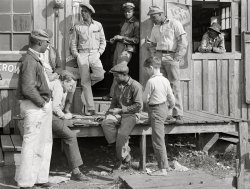
MAY CONTAIN NUTS

Search Shorpy
SHORPY ART

Framed or unframed, desk size to sofa size, printed by us in Arizona and Alabama since 2007. Explore now.
Join and Share
Ad-Free Shorpy
Shorpy is funded by you. Patreon contributors get an ad-free experience.
Learn more.

Recent comments
- What a headache!
- Baldwin 62303
- Baldwin VO-1000
- Cold
- No expense spared
- Tough Guys
- Lost in Toyland
- And without gloves
- If I were a blindfolded time traveler
- Smoke Consumer Also Cooks
- Oh that stove!
- Possibly still there?
- What?!?
- $100 Reward
- Freeze Frame
- Texas Flyer wanted
- Just a Year Too Soon
- WWII -- Replacing men with women at the railroad crossing.
- Yes, Icing
- You kids drive me nuts!
- NOT An Easy Job
- I wonder
- Just add window boxes
- Icing Platform?
- Indiana Harbor Belt abides
- Freezing haze
- Corrections (for those who care)
- C&NW at Nelson
- Fallen Flags
- A dangerous job made worse
Member Photos
The Shorpy
Print Emporium
Print Emporium
Search Shorpy
Search results -- 30 results per page
- Hanging Out: 1936
- ... full size. 35mm nitrate negative by Theodor Jung for the Farm Security Administration.
Jeans Jeans were invented during the California ... Posted by Dave - 12/21/2007 - 10:00pm -
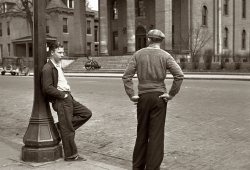
- The Hill: 1938
- ... 35mm nitrate negative by Arthur Rothstein for the Farm Security Administration. View full size.
Woman in white heels I ... Posted by Dave - 09/28/2020 - 8:21pm -
![The Hill: 1938 July 1938. "Houses on slum section 'The Hill.' Pittsburgh, Pennsylvania." 35mm nitrate negative by Arthur Rothstein for the Farm Security Administration. View full size.
Woman in white heelsI suppose one learns the best way to stand on a slope when one lives on a hill. This young lady has adopted a stance where she leans one shoulder against the wall, while angling her legs away from the wall, like a buttress. I imagine this allows her to avoid leaning backwards against the slope.
What great co-operationto allow clotheslines across the street to benefit both sides, and are those kids choosing not to be photographed?
Long GoneMy best guess is that we are in the area that was cleared for the new Civic Arena in the 1950s. The street (alley?) we're looking down runs south down the hill, toward downtown, and then bends slightly to our right and there were a few streets that bent slightly like this. The Civic Arena is gone now too and may be redeveloped into residential housing and retail spaces.
Object in the upper leftDoes anyone have any idea what sort of device that collection of metal looking things is in the upper left? Antenna?
[Bean vines. - Dave]
One man's slum is another man's neighborhoodI have read that it was still a decent working-class neighborhood in the 1930s, but declined thereafter. In the summer of 1956, some 1,300 structures were razed, displacing 8,000 residents, most of them Black. The Civic Arena and acres of parking rose of the site, making possible a concert by the Beatles (1963) and hockey by Mario Lemieux (1984-2006).
(The Gallery, Arthur Rothstein, Pittsburgh)](https://www.shorpy.com/files/images/SHORPY-8a09987a.thumbnail.jpg)
- Weed Hardware: 1938
- ... Medium format negative by Arthur Rothstein for the Farm Security Administration. View full size.
Main Street Vincennes ... Posted by Dave - 12/17/2016 - 5:23pm -
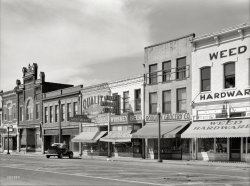
- Turnip Salad: 1941
- ... Georgia." Medium format negative by Jack Delano for the Farm Security Administration. View full size.
My favorite flower I can't ... Posted by Dave - 05/13/2019 - 3:48pm -
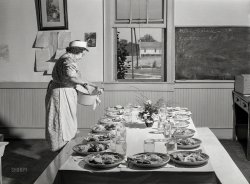
- Harvest Time: 1939
- ... Medium format negative by Marion Post Wolcott for the Farm Security Administration. View full size.
Not Exactly the Joads This ... Posted by Dave - 04/10/2019 - 3:54pm -
![Harvest Time: 1939 November 1939. "Farmers looking at their checks outside tobacco warehouse after auction sales. Durham, North Carolina." Medium format negative by Marion Post Wolcott for the Farm Security Administration. View full size.
Not Exactly the JoadsThis is the second instance we've seen in the last couple of days of late-Depression farmers (first potato, then tobacco) running around in new Buicks. Surely John Steinbeck would have been surprised.
Explosive proximityThis photo was taken about five blocks from where the fatal gas explosion occurred in Durham yesterday.
Shorpy Vehicle Identification Imperative1939 Buick 4 door sedan
Taint necessarily so Standing next to a car does not mean that it is yours. A pickup would be more appropriate for the farmers seen here.
Pinstriped wheelsNotice the triple stripes on the wheels. Done by hand for sure!
[Incorrect. - Dave]
Buyer's car, perhaps?The chrome window trim identifies that '39 Buick as a Century Series 60. I would bet the car belongs to one of the tobacco buyers rather than one of the farmer/sellers.
The carThe car is a Century I reckon - it has the fatter 7.00 x 15" tyres whereas the similar looking Special was on skinnier 6.50 x 16s.
(The Gallery, Agriculture, Cars, Trucks, Buses, M.P. Wolcott)](https://www.shorpy.com/files/images/SHORPY-8c10847a.thumbnail.jpg)
- Earth Rover: 1939
- ... format acetate negative by Marion Post Wolcott for the Farm Security Administration. View full size.
Thought I saw Hydraulics ... Posted by Dave - 04/22/2021 - 10:18am -
![Earth Rover: 1939 April 1939. "A whirling plough used by United States Sugar Corporation in soft powdery muck to prepare soil for planting sugarcane. Near Pahokee, Florida." Medium format acetate negative by Marion Post Wolcott for the Farm Security Administration. View full size.
Thought I saw HydraulicsBefore I enlarged the photo the springs that keep down force on the tool in the ground looked like hydraulic cylinders. Thinking it was early to see them. Further inspection shows the plough is moved by chains coming from the front of the machine. Possibly not even a diesel yet too. A friend of mine had a road grader on his property in Maine to service the miles long dirt road into his property. The machine was from about 1930 or so. A full size grader pretty much like you see today. It was powered by a four cylinder engine from a Model T. Back then it wasn't all brute power but more engineering and gearing. So much for the golf club carrying 600HP half ton pickups today.
[Here's a side view of this Caterpillar tractor. - Dave]
He has styleIf we could transport the driver to today, he could attend a steampunk party and fit right in.
Unique tractor The wide low ground pressure treads with a special grouser profile on the trackpads make this machine suitable to work the type of ground described. I would like to see the PTO arrangement on the front that powers those chains to lift that heavy booger of an implement.
In reply to Mark P, it is a Cat RD6 diesel. Three cylinders with pistons the size of small coffee cans and eight inches of stroke. It was governed at about 800 RPM but did its best work down about 600 with the throttle wide open. It had enough raw grunt to affect the rotation of the earth if you had it pulling in the right direction. The only thing using gasoline was the two cylinder pony motor used to start the main engine. For many years around many mining and construction sites the morning quiet was shattered by the sharp cracking exhaust of unmuffled Caterpillar pony motors.
It’s a dieselI took some time to look around and unfortunately can’t figure out which model this is but diesels in Cat products were very common back then. This one is definitely diesel since it has an injection pump and a 3 cyl engine as there are three injector lines. Cat made some gas stuff but by the middle of the '30s they made half of all the diesel power in the US.
(The Gallery, Agriculture, Florida, M.P. Wolcott)](https://www.shorpy.com/files/images/SHORPY-8c09820a.thumbnail.jpg)
- Anytown, USA: 1941
- ... Medium format acetate negative by John Vachon for the Farm Security Administration. View full size.
Shiny That house is so ... Posted by Dave - 03/20/2020 - 5:07pm -
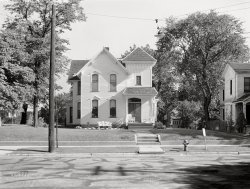
- Future Farmer: 1939
- ... seen here yesterday. Photo by Arthur Rothstein for the Farm Security Administration. View full size.
No Comments Yet? Don't tell ... Posted by Dave - 12/24/2017 - 10:43am -
![Future Farmer: 1939 September 1939. "Bud Kimberley, a future farmer of America, driving a tractor. Jasper County, Iowa." The brother of Margaret, seen here yesterday. Photo by Arthur Rothstein for the Farm Security Administration. View full size.
No Comments Yet?Don't tell me I'm the first to comment about a young Paul Newman driving that tractor?
Keeping up with the KimberleysMargaret Lou's two brothers, James and Howard, outlasted World War II. Generations of the extended Kimberley family included owners of at least six farmsteads in northwestern Jasper County and southeastern Story County, small-town bankers, county and state agricultural agents, and many others. According to a 2016 Des Moines Register story, Kimberley Farms Co. now owns or rents over 4,000 acres in Jasper, Story and Polk Counties. One of its farms has been visited twice by Chinese President Xi Jinping, who announced plans to use it as the model for a demonstration farm in Hebei province.
James Bud Kimberley 1922-1993December 25, 1922 to Feb. 3, 1993.
James Bud Kimberley of Collins, Iowa, died age 70 of a heart attack at his home in rural Collins.
He was born to John B. and Carrie (Dunlap) Kimberley at Collins. He was a lifelong resident in the Collins area, graduating from Collins High School and attending Iowa State University for one year. He married Alta Harris on Nov. 21, 1942, at the Little Brown Church at Nashua. He was a self-employed as a farmer. He was a member of the Collins United Methodist Church and was a Mason.
Survivors include his wife, Alta, of Collins: his three daughters, Nancy Smith and Jean Nielsen, both of Chicago, and Kerry Funke of Norwalk; five grandchildren; and two sisters, Margaret Fisher of Twin Lakes and Blanche Bodie of Knoxville.
A-C WCThere isn't much shown of the tractor Bud is driving - so I had to do some digging.
It appears to be an Allis Chalmers WC series tractor. The stamped end of the fuel tank makes this an earlier model; later versions of the tractor had rounded tanks.
[Below, more of Bud and his tractor. - Dave]
(The Gallery, Agriculture, Arthur Rothstein)](https://www.shorpy.com/files/images/SHORPY-8b18317a.thumbnail.jpg)
- Sole Proprietor: 1938
- ... Medium format acetate negative by Sheldon Dick for the Farm Security Administration. View full size.
Fewer and fewer I reached ... Posted by Dave - 08/30/2019 - 10:55am -
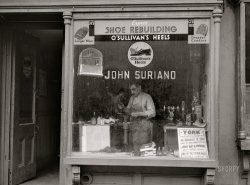
- The Farmer's Daughter: 1938
- ... near Mechanicsburg, Ohio." Photo by Ben Shahn for the Farm Security Administration. View full size.
A familiar look Reminds me ... Posted by Dave - 02/13/2014 - 9:09pm -
![The Farmer's Daughter: 1938 Summer 1938. "Daughter of Virgil Thaxton, farmer, near Mechanicsburg, Ohio." Photo by Ben Shahn for the Farm Security Administration. View full size.
A familiar lookReminds me of the "Girl With a Pearl Earring" painting by Vermeer. But it's doubtful these ears are pierced.
Calling LeonardoThis lovely young lady bears a striking resemblance to the subjects of any of a number of Renaissance portraits, one that the headband heightens remarkably.
Photography was a sidelinefor Ben Shahn, who was best known for his painting and lithography, most of it in the social realist style and dealing with left-leaning issues such as the labour movement and immigration. This poster of his will be familiar to many readers.
With benefit of the '40 CensusThat is most likely Kathleen Thaxton, who would have been about nine in the summer of '38. One sister (Juanita) would have been about 13, and mother Cora would have been about 48. According to a very recent obituary of her youngest sister Helen, Kathleen became Kathleen Dipple. Mother Cora died in 1949 and Father Virgil in 1957, but Helen's obit states that Juanita still lives in Ohio.
[This girl is the older daughter, Juanita. - Dave]
WowWhat a stunning, beautifully composed photograph.
(The Gallery, Ben Shahn, Kids)](https://www.shorpy.com/files/images/SHORPY_8a17962a.thumbnail.jpg)
- Wife Preserver: 1939
- ... Medium format acetate negative by Arthur Rothstein for the Farm Security Administration. View full size.
Maters Maters, taters, ... Posted by Dave - 03/01/2018 - 11:45am -
![Wife Preserver: 1939 October 1939. "Mrs. H.H. Poland, wife of FSA rehabilitation client, with preserved food. Mesa County, Colorado." Medium format acetate negative by Arthur Rothstein for the Farm Security Administration. View full size.
MatersMaters, taters, beans and corn! Along with an assortment of pickles, peaches, beets and I think eggs at the top. Yes they canned eggs for the winter when the hens stopped laying.
[Those are not eggs. - Dave]
A knockoutHer smile is captivating. What a beauty!
WORK!She appears (rightly so) proud of all the work she's done.
Not eggs?Then what??
Re: Not eggsMy guess is pears.
Well done Dave!Your title is finely crafted.
(The Gallery, Arthur Rothstein, Kitchens etc.)](https://www.shorpy.com/files/images/SHORPY-8b18765a.thumbnail.jpg)
- Rolling in Dough: 1940
- ... Medium format acetate negative by Edwin Rosskam for the Farm Security Administration. View full size.
Still there: Solid as a ... Posted by Dave - 05/16/2019 - 10:20pm -
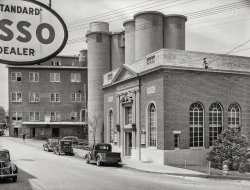
- Laramie Yards: 1941
- ... format acetate negative by Marion Post Wolcott for the Farm Security Administration. View full size.
Graffiti I notice not one ... Posted by Dave - 11/21/2019 - 8:39pm -

- Cow Town: 1941
- ... Chicago." Medium format negative by John Vachon for the Farm Security Administration. View full size.
Long Gone When I was a ... Posted by Dave - 12/27/2017 - 3:21pm -
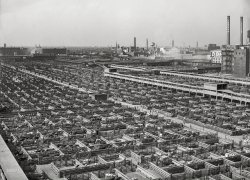
- Rancho Geranium: 1936
- ... room. Mercer County, Illinois. Hired man lives in house on farm that was formerly residence of owner-operator." Photo by Russell Lee for the Farm Security Administration. View full size.
No wonder Dave and tterrace ... Posted by Dave - 05/24/2018 - 5:10pm -
![Rancho Geranium: 1936 November 1936. "Window of farmhouse living room. Mercer County, Illinois. Hired man lives in house on farm that was formerly residence of owner-operator." Photo by Russell Lee for the Farm Security Administration. View full size.
No wonder Dave and tterrace are tiredThe answer from tterrace to IllinoisBoy reminded me of something I've been meaning to mention. Not sure the average Shorpy.com viewer realizes how many photos the Shorpy crew must have to wade through to find their wonderful offerings.
Over 30 years ago, I was working at an engineering firm outside D.C. and one of the suits there wanted to see every public-domain photo of hurricane damage. So I went to the Library of Congress, first to the old building, and then to the LoC Jefferson (I think) building across the street, to see what they had.
They had about a million filing cabinets with sorted and labeled plates, prints and negs, and I, of course, when shown all that said, "To heck with it."
Same with the Pentagon's photo collection. I used to go to their photo lab at Bolling AFB, and there were three or four Navy guys in civvies digitizing all their imagery using flatbed desk scanners. The director said they had over 5 million images to scan and classify. I said, "With those few guys scanning one by one, how long's that gonna take?!?!?" and the director said, "We figure about 250 years."
Of course, fast and automated scanning came out and that stuff is probably all online already, but it's still a lot of imagery to wade through. So thanks to the Shorpy.com team!!!
Further Information?I'm very curious if there is any further information regarding this photo or the collection?
My great x3 grandfather homesteaded in Mercer County IL in the early 1850's. For several generations my family continued to farm just outside of New Windsor until the early 1980's.
[It's part of this collection at the Library of Congress. -tterrace]
(The Gallery, Agriculture, Russell Lee)](https://www.shorpy.com/files/images/SHORPY-8b29943a.thumbnail.jpg)
- Elko Depot: 1940
- ... Medium format negative by Arthur Rothstein for the Farm Security Administration. View full size.
Airplanes The markings on ... Posted by Dave - 02/20/2018 - 11:01am -
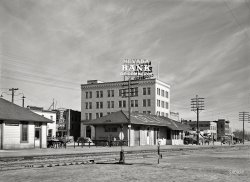
- Berrien Bunkhouse: 1940
- ... Medium format acetate negative by John Vachon for the Farm Security Administration. View full size.
Not the Hilton But better ... Posted by Dave - 06/19/2020 - 9:34am -
![Berrien Bunkhouse: 1940 July 1940. Berrien County, Michigan. "Old barn used as bunkhouse for migrant fruit pickers from the South. This grower employs only unmarried Negroes." Medium format acetate negative by John Vachon for the Farm Security Administration. View full size.
Not the HiltonBut better accommodations by far than those endured by the man with his sons and (I assume) his wife, living and sleeping in the back of a truck. But what is that black hairy-looking stuff on the walls?
Soot WebsThose webs are actually caused by charged particles of debris floating in the air that are leftover from whatever they have been cooking on the stove. This is common to see in homes that have had a fire loss or you can find them in the homes of heavy smokers.
They look creepy but it's just science doing its thing. Consider this a benefit of fire and mold remediation classes. The sad thing is, in a fire loss, clean-up companies and claims adjustors have to continually let distraught insureds know that it's not because they didn't keep their house clean, but because of the smoke that was present in the fire.
Here's one of many resources put out by ServPro that explain this phenomenon: https://www.servproofnortheastwichita.com/blog/post/100600/fire-smoke-da...
Tangled websI believe the "black hairy-looking stuff" JennyPennifer inquired about is an accumulation of soot-covered cobwebs. The major cause of the soot, of course, is visible at right.
At least they'll stay warmYes, these are better accommodations than were provided for a lot of the migrant families we've seen on Shorpy. They even have a stove. So I wonder, was it easier for the unmarried migrant workers to get the best paying jobs with the better housing? Although the poor gentleman in the polka-dot socks is in desperate need of a new pair of shoes.
[Wives and kids require extra housing. Hence the preference for bachelors. - Dave]
Much we still don't knowI question Tamara's statement that these bachelors obtained the best paying jobs for this work. They were also selected because they were negroes. From what I know about 1940s America, a negro work crew would have been paid less than a white one … or charged more for lodging, food, etc.
I understand migrant workers with families have less personal time to devote to themselves. Still, I am struck by how well groomed are these four men. Each one is clean shaved, except the one mustache, which is neatly trimmed. Their hair is neatly cut. Maybe they helped one another keep groomed?
Well groomedThey work hard during the day but still have hopes of getting lucky at the nightly dances! They need to look nice.
(The Gallery, Agriculture, John Vachon)](https://www.shorpy.com/files/images/SHORPY-8c17667a1.thumbnail.jpg)
- The Summer of ’41
- ... in Caldwell, Idaho. 35mm nitrate negative by Russell Lee, Farm Security Administration. View full size.
Neat I live in Boise, Id so ... Posted by Dave - 06/30/2009 - 2:56pm -
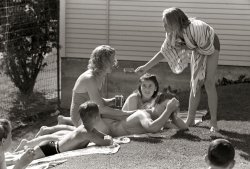
- The Cat in the Hat: 1939
- ... August 1939. Yakima Valley near Wapato, Washington. Farm Security Administration client Chris Adolph. "My father made me work. That was ... Posted by Dave - 07/05/2009 - 2:41am -
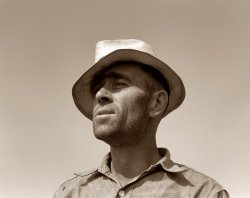
- Step Children: 1941
- ... Vermont." Acetate negative by Jack Delano for the Farm Security Administration. View full size.
The kids Happy, warm, and ... Posted by Dave - 11/10/2019 - 2:24pm -
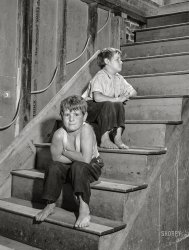
- Well-Preserved: 1940
- ... Medium format acetate negative by Russell Lee for the Farm Security Administration. View full size.
Undoubtedly, to her ... ... Posted by Dave - 09/12/2020 - 12:11pm -
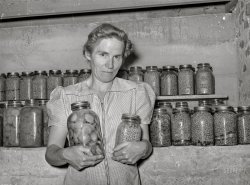
- Nitty Gritty Dirt Band: 1940
- ... Medium format acetate negative by Russell Lee for the Farm Security Administration. View full size.
If pianos could talk that ... Posted by Dave - 03/02/2010 - 10:35am -
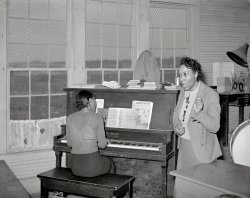
- Ophir Station: 1940
- ... and takes out the ore." Photo by Russell Lee for the Farm Security Administration. View full size.
There's a whole book on ... Posted by Dave - 09/04/2018 - 1:16pm -
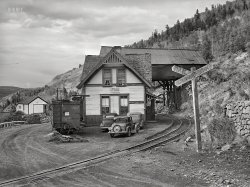
- Portsmouth Parkers: 1941
- ... Medium format acetate negative by John Vachon for the Farm Security Administration. View full size.
Economic Prozac Except for ... Posted by Dave - 02/16/2021 - 8:29pm -
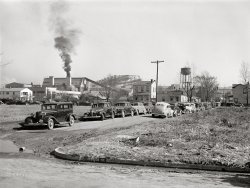
- Normal: 1940
- ... Louisiana." Photo by Marion Post Wolcott for the Farm Security Administration. View full size.
Louisiana State Normal School ... Posted by Dave - 06/27/2019 - 12:13pm -
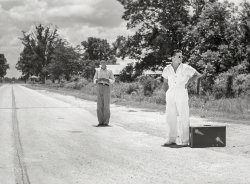
- Look Downward Angle: 1941
- ... Medium format acetate negative by John Vachon for the Farm Security Administration. View full size.
Bombs Away! I feel like I ... Posted by Dave - 02/05/2020 - 11:57am -
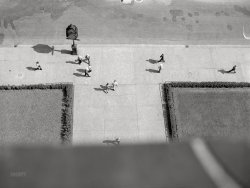
- Reading Circle: 1942
- ... came to Southington in late May, 1942, for the Farm Security Administration, to photograph life in a typical American town, which, other ... Posted by Dave - 04/15/2015 - 4:41pm -
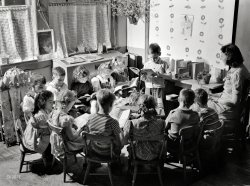
- Cajun Girls' Night Out: 1938
- ... Raceland, Louisiana." 35mm negative by Russell Lee for the Farm Security Administration. View full size.
Horses and Mules Love the ... Posted by Dave - 04/10/2008 - 9:31pm -
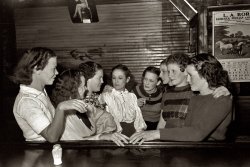
- Blades, Combs, Laces: 1939
- ... full size. 35mm nitrate negative by Russell Lee for the Farm Security Administration.
Razors Looks like he is selling a couple of Gem ... Posted by Dave - 07/05/2009 - 1:58am -
![Blades, Combs, Laces: 1939 November 1939. "Street vendor's goods. Waco, Texas." View full size. 35mm nitrate negative by Russell Lee for the Farm Security Administration.
RazorsLooks like he is selling a couple of Gem Razors. I can tell by zooming in a bit that the G-P Blades are single edge (for the Gem Razors he is selling) but he's also got several brands of double edge blades...the Fan blades, the Smith Blades...which would go in a Gillette Tech or Aristocrat (which he doesn't seem to stock in his little box). I'm a razor nerd...I wish I could run across some kid selling these on the street today. I'd buy him out.
Josh
PS- Those Gem razors are kind of hard to use these days. The blades you can get for them are not always the best quality. If you've ever seen Treet razor blades in the drugstore (you might have bought them to use as a scraper, or to put in a utility knife maybe or for a crafts project) that is what you can get today and that's about it. They tend to be a bit rough. Double edge blades are still easy to find though and high quality blades are relatively easy to source on the internet, allowing these great old razors to still perform today just like they did way back then. One of my favorite razors is a Gillette Tech from a little later than this (1940s) that shaves like a dream and looks brand new 60 years later. They don't make them like this anymore.
[Click below to enlarge. - Dave]
John RuskinWas the John Ruskin box from razors, or cigars (it looks a bit like a cigar box), or from something else entirely? How odd to contemplate an America in which John Ruskin's name could be used to sell anything!
I imagine his name was associated with sophistication in an era before everything went lowbrow.
[Cigar box. - Dave]
SharpI'm a razor nerd also. Interesting picture.
(The Gallery, Great Depression, Russell Lee)](https://www.shorpy.com/files/images/8a27487u_0.thumbnail.jpg)
- Your Move: 1941
- ... format acetate negative by Marion Post Wolcott for the Farm Security Administration. View full size.
Love these pictures of life! ... Posted by Dave - 09/22/2019 - 1:11pm -
